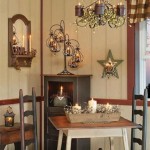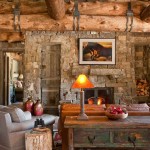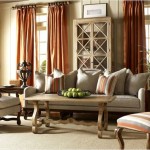How To Decorate An Open Floor Plan Home
Open floor plans have become a popular architectural design choice, offering expansive living spaces characterized by fewer walls and a greater sense of flow. While these plans provide numerous benefits, such as increased natural light and enhanced social interaction, decorating them can present unique challenges. Successfully decorating an open floor plan requires careful consideration of space delineation, furniture arrangement, and cohesive design elements to create a functional and aesthetically pleasing environment.
The appeal of open floor plans lies in their flexibility and adaptability. They allow residents to customize their living space according to their individual needs and preferences. However, the lack of physical barriers can also lead to a feeling of emptiness or disorganization if not properly addressed. The key to effectively decorating an open floor plan is to create distinct zones within the larger space, each serving a specific purpose while maintaining a harmonious overall design.
Defining Zones within the Open Space
One of the most crucial aspects of decorating an open floor plan is defining distinct zones for different activities. This can be achieved through various techniques, including furniture arrangement, area rugs, and changes in flooring or wall color. The goal is to visually separate each zone without completely isolating it from the rest of the space.
Furniture arrangement plays a vital role in creating these zones. For example, a large sectional sofa can be used to delineate the living room area from the dining area. By positioning the sofa with its back facing the dining area, a clear visual boundary is established. Similarly, a console table placed behind the sofa can further define the space and provide additional storage or display space. The positioning of furniture should encourage conversation and flow within each zone, while also creating a clear sense of separation.
Area rugs are another effective tool for defining zones in an open floor plan. A large rug placed under the dining table can visually anchor the dining area and separate it from the surrounding space. Similarly, a rug in the living room area can help to define the seating area and create a more intimate atmosphere. When selecting rugs, consider the size and shape of the area to be defined, as well as the overall color palette of the room. Choosing rugs with different textures or patterns can also add visual interest and further differentiate the zones.
Changes in flooring or wall color can also be used to create visual separation between zones. For example, using hardwood flooring in the living room and tile flooring in the kitchen can create a subtle but effective distinction. Similarly, painting one wall of the dining area a different color than the rest of the room can help to define the space and create a focal point. These changes should be carefully considered to ensure they complement the overall design of the open floor plan and do not create a jarring or disjointed effect.
Beyond these primary methods, consider using bookshelves, room dividers, or even strategically placed plants to subtly delineate spaces. Bookshelves offer a functional and aesthetically pleasing way to create a partial barrier, providing storage while visually separating zones. Room dividers, whether folding screens or more permanent structures, can offer greater privacy and definition. Tall plants can also be used to create a natural and visually appealing barrier, adding a touch of greenery to the space.
Creating a Cohesive Design Aesthetic
While defining zones is important, it is equally crucial to maintain a cohesive design aesthetic throughout the open floor plan. This means selecting a consistent color palette, furniture style, and overall theme that ties the different zones together. A cohesive design helps to create a sense of harmony and flow, preventing the open space from feeling disjointed or chaotic.
A well-chosen color palette is essential for creating a cohesive design. Select a few key colors that will be used throughout the open floor plan, and then use variations of these colors in different zones. For example, you might use a neutral color like beige or gray as the base color for the walls, and then incorporate accent colors like blue or green in the furniture, accessories, and artwork. Maintaining a consistent color palette helps to create a sense of unity and flow, even though the different zones may have different functions.
The furniture style should also be consistent throughout the open floor plan. Whether you prefer a modern, traditional, or eclectic style, choose furniture pieces that complement each other and create a unified look. Avoid mixing too many different styles, as this can create a sense of visual clutter and disorganization. Consider the scale of the furniture as well, ensuring that it is appropriate for the size of the open space. Large, bulky furniture can overwhelm a small open floor plan, while small, delicate furniture can get lost in a large open space.
Artwork and accessories can also play a role in creating a cohesive design. Choose artwork and accessories that complement the overall color palette and furniture style of the open floor plan. Consider using a variety of textures and patterns to add visual interest, but avoid overdoing it. Too much clutter can make the open space feel overwhelming and disorganized. Stick to a few key pieces that will create a focal point and add personality to the space.
Lighting is another crucial element in creating a cohesive design. Use a combination of ambient, task, and accent lighting to create a well-lit and inviting space. Ambient lighting provides overall illumination, while task lighting focuses on specific areas, such as the kitchen counter or reading nook. Accent lighting is used to highlight artwork or architectural features. By using a variety of lighting techniques, you can create a warm and inviting atmosphere that complements the overall design of the open floor plan.
Optimizing Functionality and Flow
In addition to defining zones and creating a cohesive design aesthetic, it is important to optimize the functionality and flow of the open floor plan. This means considering how people will move through the space and ensuring that each zone is designed to meet its intended purpose.
Traffic flow is a key consideration in an open floor plan. Arrange furniture in a way that allows for easy movement between zones. Avoid placing furniture in the middle of walkways, as this can create obstacles and disrupt the flow. Consider the placement of doors and windows when arranging furniture, as these can also affect traffic flow. The goal is to create a space that is easy to navigate and encourages movement.
Each zone should be designed to meet its intended purpose. The living room area should be comfortable and inviting, with plenty of seating for conversation and relaxation. The dining area should be functional and stylish, with a table and chairs that are appropriate for the size of the space. The kitchen area should be efficient and well-organized, with plenty of counter space and storage. Consider the specific needs of each zone when selecting furniture, accessories, and lighting.
Storage is often a challenge in open floor plans. Without walls to provide built-in storage, it is important to find creative solutions for storing belongings. Consider using furniture with built-in storage, such as ottomans with lift-up lids or coffee tables with drawers. Bookshelves can also be used for storage, as well as for display. Wall-mounted shelves can be a great way to add storage without taking up floor space. The key is to find storage solutions that are both functional and aesthetically pleasing.
Finally, consider the acoustics of the open floor plan. Without walls to absorb sound, open spaces can often be noisy. To improve the acoustics, consider using soft materials, such as rugs, curtains, and upholstered furniture. These materials can help to absorb sound and reduce echo. You can also use acoustic panels or sound-absorbing artwork to further improve the acoustics of the space.

How To Decorate Your Open Floor Plan Like A Pro Interior Design Home Staging Jacksonville Fl Interiors Revitalized

Decorating Your Open Floor Plan Brock Built

How To Decorate Your Open Floor Plan Christopher Companies
:strip_icc()/open-floor-plan-design-ideas-13-proem-studio-white-oak-3-57715775317c4b2abc88a4cefa6f06b7.jpeg?strip=all)
22 Open Floor Plan Decorating Ideas Straight From Designers

Open Floor Concepts That Will Transform Your Home Perry Homes

How To Decorate An Open Concept Floor Plan Interiors Revitalized

House Design Trends What S Popular In Cur Floor Plans Extra Space Storage

Open Floor Plan Decorating Ideas How To Decorate Concept Homes

Decorating Your Open Floor Plan Brock Built

Open Floor Plan Decorating Ideas Jaymarc Homes







